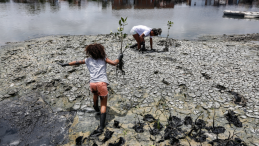On 8 May 2024 UNU-IAS, in partnership with the Institute for Global Environmental Strategies (IGES), hosted a webinar to discuss integrating landscape approaches into national biodiversity strategies and action plans (NBSAPs) to meet the objectives of the Kunming–Montreal Global Biodiversity Framework (GBF).
Suneetha Subramanian (Research Fellow, UNU-IAS) defined landscape approaches as holistic strategies that consider a particular area's ecological, social and economic context to manage local production activities in alignment with sustainability principles and biodiversity conservation. She introduced the International Partnership for the Satoyama Initiative (IPSI) — a global network to realize societies in harmony with nature through landscape approaches, strengthening the connection between science, policy and practical applications.
Andre Mader (Programme Director, Biodiversity & Forests, IGES) provided an overview of Using Landscape Approaches in National Biodiversity Strategy and Action Planning, a practical guide for integrating landscape approaches into NBSAPs. Developed by UNU-IAS and IGES, the publication helps policymakers recognize the multiple uses and users within landscapes to mitigate conflicts and promote collaborative management. UNU-IAS, IGES and IPSI plan to advocate for the incorporation of the guide into the activities of UNDP and UNEP, which support countries in updating their NBSAPs, and offer guidance through interactive workshops.
Highlighting efforts to establish a National Biodiversity Coordinating Mechanism in Kenya, Catherine Mungai (Senior Programme Officer, IUCN Regional Office for Eastern & Southern Africa) noted the country's aim to integrate biodiversity considerations into decision-making at all government levels, in line with GBF Target 14.
Juan Ramos (Senior Manager of Integrated Finance and Policy, EcoAgriculture Partners) shared recommendations for NBSAPs and National Biodiversity Finance Plans based on experiences in addressing the root causes of deforestation in San Martín, Peru with an integrated landscape finance framework. He stressed the importance of organizing and planning financial and resource mobilization needs in action plans, as lack of resources renders strategies ineffective.
Discussing the Association of Southeast Asian Nations (ASEAN) Biodiversity Plan, Carlo Carlos (Strategy and Planning Division Director, ASEAN Centre for Biodiversity) explained that it aimed to support ASEAN member states in implementing their NBSAPs through regional initiatives. The plan will focus on addressing common regional concerns that require collective action, such as managing transboundary protected areas and enhancing capacity development.
Participants discussed the importance of integrating economic incentives into strategies, including decision-making processes, emphasizing that agriculturists would be more inclined to adopt landscape approaches if they had economically viable means to produce sustainably.


